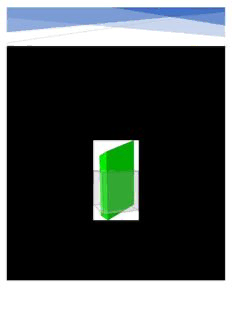
Anastasia Tzoumaka: Computational rate independent Single Crystal Plasticity with finite PDF
Preview Anastasia Tzoumaka: Computational rate independent Single Crystal Plasticity with finite
ENGN2340 – Final Project Computational rate independent Single Crystal Plasticity with finite deformations –Abaqus Umat Implementation Anastasia Tzoumaka Fall 2017 Intorduction: Single crystals, are monocrystalline solids whose structure consists of a single, continuous and unbroken grain. They are characterized by their extraordinary mechanical properties, which are mainly attributed to the absence of structural defects associated with grain boundaries. These properties and especially the inherent creep resistance of metal single crystals is the main reason for their widespread implementation in turbines and the energy industry. However, research on the mechanical behavior and constitutive modelling of single crystals is not entirely motivated by the continuous need for innovative industrial applications. Each and every metal consists of grains and grain boundaries and all metals share the same defects such as vacancies, dislocations etc. Single crystals are essentially the building block of every polycrystalline metal that existed, exist and will exist in the future since by definition, single crystals only consist of a single grain with a given spatial orientation and no boundaries. Understanding the mechanics of crystal plasticity and being able to simulate the deformation of single crystals is therefore crucial to the understanding of very important phenomena in metals such as texture, deformation induced anisotropy, grain interactions and many more. In this project we will focus on FCC crystals since they represent the vast majority of metals used in engineering applications. We will present the fundamental theory behind single crystal plasticity, outline the governing equations and describe the methods that can be used to solve the equations numerically in a finite element setting. The constitutive model will then be implemented in a User MATerial subroutine that can be used with the Abaqus commercial FEA software and the code will be tested in a series of simulations designed to assess the convergence and validity of the results. Elastoplastic equations: The physically based assumption, that crystal plasticity is the result of simultaneous simple shears along the crystal's active systems allows us to express the velocity gradient associated with plastic slip as (Bower): where s,mare the unit vectors along the slip and normal directions of slip system α respectively, 0 0 defined in the reference configuration . The summation in the above equations is carried over 0 the active systems at the time of calculation Nas (Number of Active Systems). Now recalling that the deformation rate D and spin tensor W are defined as the symmetric and skew parts of L respectively, we can also define: The multiplicative decomposition of the deformation gradient F : The slip direction vector sis embedded in the lattice and transforms during deformation according 0 to s Fes. In contrast, the unit normal to the slip plane m transforms as m Fem, so that 0 0 0 it constantly remains perpendicular to the slip plane. The Elasticicty Matrix: The constitutive relationship for the elastic behavior of an FCC metal single crystal is taken to be that of an linearly elastic solid with cubic symmetry. In this case the constitutive law can be parameterized with respect to 3 independent material constants and with respect to the crystal axes can be written in the form (Bower): Where: Is the elasticicty matrix with respect to the crystal axes and in terms of C . ij Finally: Hardening of Single Crystal: The Bassani-Wu Model A typical stress--strain curve of an FCC metal crystal exhibits three distinct deformation stages (Haidemenopoulos ). Initially, in Stage I, plastic slip is attributed to the activation of only one out of the twelve possible slip systems that FCC crystals comprise of 12 slip systems resulting from all possible combinations between their 4 dense planes <111> and 3 dense directions <110> The yield criterion of each slip system α is defined in terms of the resolved shear stresses and is expressed in rate form as: The consistency condition then takes the following form for every slip system a: The hardening model proposed by Bassani and Wu is then summarized as: Rate Independent Tangent Modulus • Elasticicty: • Plasticity: Where: []1 UMAT implementation – Stress Update Algorithms : The resolved shear stress within each slip system a can be calculated as: The hardening of each slip system is then expressed as: The yie ld conditions of all slip systems are then introduced in terms of the two above equations: Therefore, the unknowns are determined as the solution of the following system: Only numerical solutions are applicable to the above equation since both and are highly non- cr -linear functions of the unknowns . Implementing the Newton Raphson method, we can iteratively solve for the unknowns until convergence is achieved. Newton iterations for multivariate systems however, require the Jacobian matrix of the system, which in this case is defined as (a /). Next, we calculate the derivatives necessary to build the Jacobian matrix: • Variation of Fewith respect to : • Right Cauchy-Green elastic tensor variation: • Green strain variation: • 2nd Piolla – Kirchhoff’s variation: • Calculating the derivative (/) • Variation of the resolved shear stress on a system with respect to all slips • Criticla shear stress variation : • Final expression of the elastic Jacobian Figure 4: Schematic representation of the stress update algorithm Results : Figure 5 illustrates the anisotropic and non-uniform deformation of the sinlg crystal specimen presenting the actual undeformed and deformed shapes before and after the uniaxial analysis. Figure 5: Undeformed and deformed configuration The finite element results for the uniaxial tension are presented in figure 6 by plotting the macroscopic true stress-logarithmic strain curve. Figure 6: Stress - logarithmic strain curve for uniaxial tension
Description: